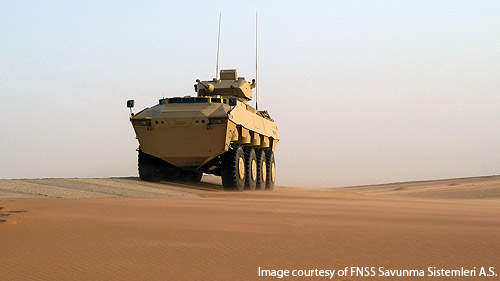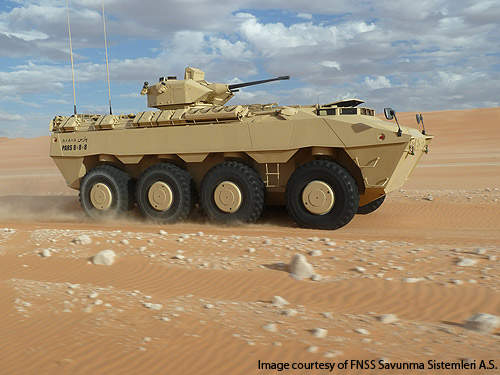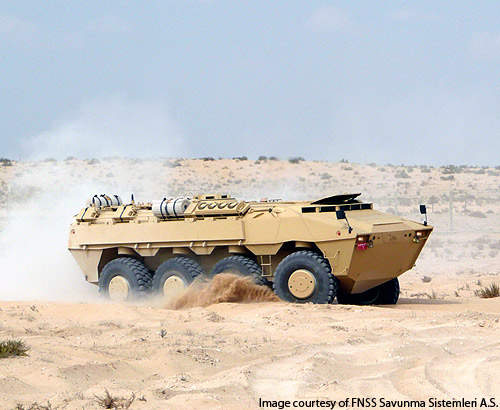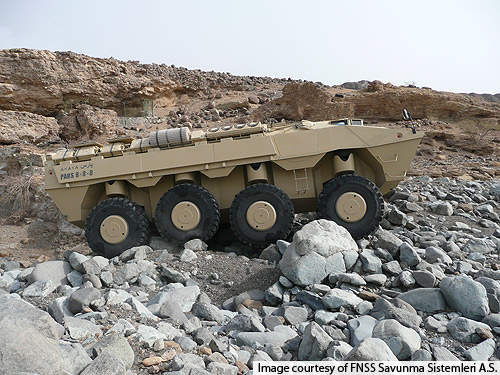The Turkish PARS wheeled armoured combat vehicle.
The PARS is a new generation wheeled amphibious armoured combat vehicle being designed and manufactured by FNSS Savunma Sistemleri (FNSS), Turkey for the Turkish Armed Forces as well as for international markets.
The vehicle was developed with special emphasis on the areas of mobility, protection, payload, and growth potential. The vehicles employ the latest designs and technology from commercial automotive industries, which have been militarised to meet the performance and durability of modern military operational requirements.
PARS armoured combat vehicle family
The vehicles are based on a system of vehicles to include a 6×6, 8×8, and 10×10 using significant commonality of each vehicle sub-system, thereby reducing the ‘logistics foot print’ and lifecycle costs.
The vehicles are being built in two different configurations namely PARS 6×6 and PARS 8×8. They can be easily transported in air by the C130 (PARS 6×6), A400, C17 and C5 Galaxy. Two crew members (a driver and commander) seated in the front section of the cockpit control the vehicle. Based on different configurations, the vehicle can accommodate PARS 6×6 (8 to 11) and PARS 8×8 (13 to 16).
The Mobile Amphibious Assault Bridge (MAAB) configuration of the vehicle was scheduled to enter into service with the Turkish Armed Forces in 2012.
PARS combat vehicle orders and deliveries
FNSS received a contract to develop and manufacture 52 MAAB for the Turkish Land Forces signed in early 2007. The MAAB system is based on the PARS 8×8 and suspension elements of the PARS are used in this vehicle.
FNSS has received an order for 1,000 PARS armoured vehicles from the Turkish Army. The Turkish Navy will procure 50 amphibious PARS vehicles.
The Malaysian Ministry of Defence signed a letter of intent with DRB-Hicom Defence Technologies (Deftech) in April 2010 for 257 indigenous armoured vehicles called AV8. The AV8 is based on PARS vehicles. The contract was eventually signed in 2011 with an overall project budget of $2.5bn. Deliveries are scheduled to take place between 2012 and 2018.
PARS (6×6) is one of the three known contenders for the Turkish Land Forces Command (TLFC) requirement for 336 (6×6) reconnaissance vehicles in five versions which are command, support, sensor, radar and CBRN reconnaissance vehicles.
PARS 8×8 armoured vehicle design
The baseline PARS 8×8 vehicle has a hull consisting of a steel armour.
The driver and commander are seated in a cockpit at the front of the vehicle. Each has a single-piece roof hatch that opens to the side. Both have access to flat-panel displays, on which all relevant information is shown.
The seating arrangement depends on the role but the troops are normally seated on individual seats down each side of the hull facing inwards. These shock-absorbing seats are fitted with five-point seatbelts as standard. A large ramp fitted at the rear section will be used for entry and exit of troops.
The modular design of the PARS will incorporate external turrets or weapon stations depending on user requirements. It could be a one or two-man turret or a remotely operated weapon station.
To allow for PARS to be rapidly reconfigured for different operational roles, all members of the PARS family have removable roofing so that they can be quickly converted for a wide range of specialist roles.
Development
The development of the PARS vehicles commenced in 2002. PARS 6×6 is being proposed for the Turkish Army. PARS 8×8 was first displayed in February 2005 during the IDEX defence equipment exhibition held in Abu Dhabi. Since the first PARS vehicles were shown in 2005 development and further enhancements have been carried out on a continuous basis.
The PARS 8×8 vehicle was examined by the Malaysian Army in 2006 competing with the Swiss Piranha IIIC and the Finnish Patria AMV. It was demonstrated in the deserts of the UAE in 2008 covering 11,000km of desert and road trials. Further testing was again carried out in the UAE deserts in 2010. The PARS 8×8, fitted with a 25mm gun turret, was also successfully tested by another Middle Eastern country in the summer of 2010.
Features
The PARS armoured vehicle will feature a V-shaped hull, four axles, four access doors, a trapezoidal block, two lighthouses, an automatic drive train management system, a 2.2kW auxiliary power unit (APU), a 133kN self recovery hydraulic winch and eight wheels.
The vehicle will have a rectangular-shaped shell equipped with built-in headlights in the hull. It will be fitted with a gearbox comprising six forward gears and one reverse gear.
Armaments
The vehicle can be equipped with a wide range of armaments from 7.62mm MG to air defence guns and missile systems depending on the user requirements. The PARS is already fitted with a 25mm FNSS Sharpshooter Turret which can fire munitions at the rate of 200 rounds per minute.
Due to the high axle capacity of the vehicle, weapons systems such as two-man turrets, 120mm mortar systems, air defence guns, missile systems, and 90mm turrets can also be fitted onto the vehicle.
Observation
One of the most significant features of the PARS vehicles is situational awareness. The PARS vehicles include a unique feature where the vehicle commander and driver sit side-by-side. For enhanced visibility, there are two thermal cameras in the front and rear, as well as two optical cameras at the front and rear. Local situational awareness is significantly enhanced.
Visual images are displayed on two large flat panel screens located in front of the driver and commander. The screens also display vehicle location through its GPS, as well as status and fault information on vehicle systems. Seven to eleven large periscopes are also fitted to the “cockpit” at the front of the vehicle for the driver and commander to view their surroundings and to provide space side-by-side for either to operate the vehicle left or right hand drive.
Protection
Protection for the PARS vehicle system is mainly achieved through the design of the vehicle hull and related appliqué systems, combined with complete capability for dealing with mine blasts, IEDs, ballistics, and overhead protection.
These systems are easily attached to the deep “V” hull, allowing ballistic protection levels to be changed quickly for specific missions or situations.
Engines
The PARS is currently powered by a Deutz engine, which has 523hp of output power.
Mobility
The high mobility of PARS vehicles comes from its newly developed, active pneumatic independent suspension system. The vehicle is equipped with independent suspension at all wheel stations, which provides commonality between each station, thereby reducing logistics and improving life cycle costs.
The pneumatic suspension system is electronically controlled and allows the ground clearance to be set for optimal performance. The vehicle’s variable height suspension enables the vehicle to hide behind obstacles to reduce enemy visibility. The vehicle can utilise a large selection of tyre sizes.
The PARS vehicle’s enhanced mobility is aided by a suspension travel of 450mm, full wheel drive, incorporating automatic drive line management, as well as central tyre inflation and an anti-lock braking system.
The PARS vehicles have an effective all wheel steering system that is equally well suited to high-speed highway driving or manoeuvring in tight narrow urban streets. All of this high performance steering capability is done simply and automatically for the driver and is transparent to him in the operation of the vehicle.
The PARS can accomplish a maximum road speed of 100km/h. The vehicle can travel at 3km/h during low-speed manoeuvring. It is designed to ford to a depth of 1.5m. The vehicle can also cross the river at a speed of 8km/h using optional hydrojets.







